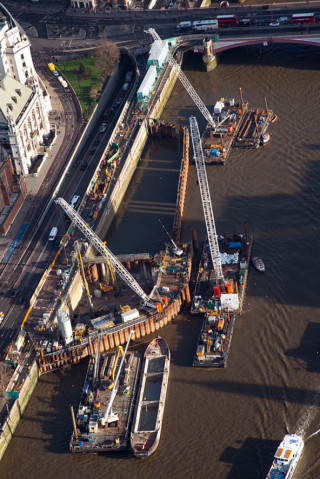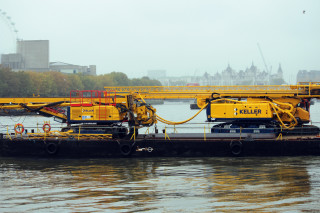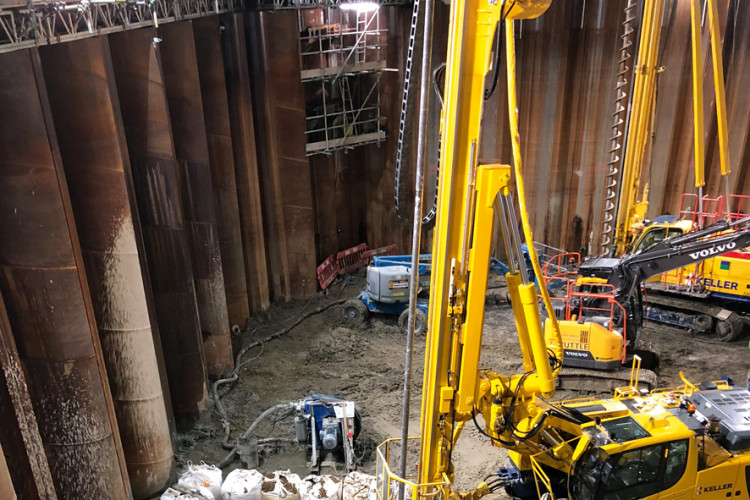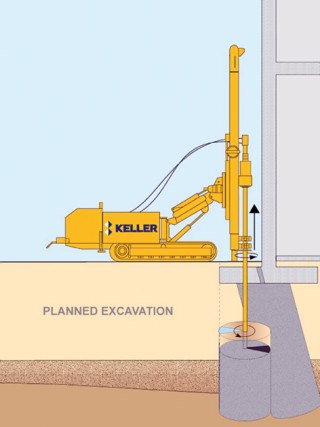The Blackfriars Bridge foreshore site drop shaft, on Thames Tideway’s central section, is designed to connect the existing Fleet sewer outfall and the Northern Low Level 1 sewer under the bridge – one of the city’s most polluting discharge points – to the new tunnel.
But constructing the 53m-deep, 24m-diameter shaft presented several challenges due to the central London location and restricted working area over the river.
The main contractor for the central section, Ferrovial Agroman/Laing O’Rourke JV, asked Keller to assist by using a combination of jet grouting and sprayed concrete to line the massive excavation.
The task required jet grouting to a depth of 65m and for Keller, as well as the rest of the team, this represented a first. Never before had jet grouting been carried out at such depths in the UK, within the target strata and with the column diameters required.
“The original intention was to install diaphragm walling, which is often used for shaft construction, but that wouldn’t have been possible due to the constraints of the site,” says Bruce Stephenson, Keller’s contracts manager. “So the designer asked if jet grouting the sand layers – which would be faster and more cost-efficient – was an option.”
With little experience of using that technique at such extreme depths within the target stratum, Keller proposed a trial to validate the concept before attempting it at Blackfriars.
The Keller team, with support from its ‘global product team’ (GPT), carried out the trial at Tideway’s Kirtling Street site in Wandsworth, the launch site for the project’s two tunnel-boring machines. The trial yielded valuable data and proved that the column diameter could be maintained at depth.
One of the potential problems when drilling at great depth is deviation of the drilling column from the intended trajectory. On this project, the problem was compounded by the need to form columns in difficult strata; the objective of the trial was therefore to ensure that diameters of approximately 2m could be achieved and that ‘interlock’ between grouted columns was possible within the potential deviation of the drill.
According to Keller, the trial’s success was largely down to the performance of its patented Soilcrete system, which directs jets of air and grout at consistently high pressure and velocity to disaggregate the soil (see box p35). The company says that the Soilcrete equipment is more efficient than standard jet assemblies and creates a more stable and efficient product with larger-diameter columns.

The trial at Kirtling Street showed that jet grouting was viable. And, after some improvements to the design to increase the column diameters to around 2.2m, Keller was awarded the Blackfriars shaft contract. Engineers then spent several months working closely with the client to plan the work.
One of the main challenges for Keller was the actual site itself. “The Blackfriars site was complex because there was very little space to work,” says Stephenson. “The site literally had to be built up out of the river using a cofferdam around 11m wide and 80m long, with the lower level barely any bigger than the shaft diameter itself. Once we had all the equipment, there was little room to manoeuvre.”
That equipment included a 52-tonne KB6 drill rig, a high-capacity mixer, two high-pressure grout pumps (one for backup), an excavator and 8,000 tonnes of cement. In order to reduce vehicle movements through London’s congested roads, everything was delivered to site by barge.
The project began in September 2018, with three crews working in shifts around the clock for three months solid to complete the jet grouting.

“A project like this takes a lot of hard work by a lot of people to make it a success, and we were able to call on an international team of experts, both in the design and construction phases,” says Stephenson, who claims that no method other than Keller’s Soilcrete jet grouting system would have been able to achieve the same result.
The contract also owed much of its success to meticulous planning and liaison with the main contractor: “We were able to work closely with the client for months to plan everything, right down to the last detail,” says Stephenson.
“As a company we’ve learned a lot from this. All that information on deep drilling, drill deviations and jet grouting in these conditions can now be fed into the rest of the Keller Group via the GPT, broadening our portfolio,” he says.

What is jet grouting?
Jet grouting is a soil improvement method that uses high velocity fluid jets to construct columns of cemented soil either to provide excavation supports, seal the bottom of planned excavations or permit the excavation of unstable water-bearing ground.
The method works by pumping the high velocity jets – usually a combination of cement grout, water and/or air – through a drill head to impregnate the soil surrounding the drill stem.
The drill is first advanced to the maximum depth and then steadily withdrawn while being rotated as the grout mixture is being pumped.
The high-pressure jet mixes the soil with the grout to produce a column of firm, stable material that can support loads and resist water penetration.
The jet grouting method can be used with a wide range of soil types, including silts and most clays, and is especially effective in locations where space is limited or subsurface obstacles, such as utilities, are nearby.
This article was first published in the June 2019 issue of The Construction Index magazine
UK readers can have their own copy of the magazine, in real paper, posted through their letterbox each month by taking out an annual subscription for just £50 a year. Click for details.
Got a story? Email news@theconstructionindex.co.uk




